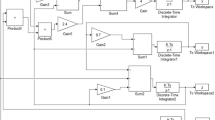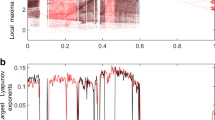Abstract
The dynamical analysis, field programmable gate array (FPGA) implementation and image encryption of a linear piecewiseresistive-capacitive-inductive shunted Josephson junction (LPRCISJJ) model are reported in this paper. The numerical simulations of LPRCISJJ model reveal the existence of periodic attractors, bistable periodic attractors, antimonotonicity phenomenon and hidden chaotic attractors with different shapes by varying its parameters. Numerical simulations and FPGA results produce alike timing evolutions and phase planes. Chaotic LPRCISJJ model is used as a pseudo-random number generator (PRNG) in the design of cryptography algorithm based on bit-level permutation. The designed algorithm performs bit masking and relocation depending on the amount of information the bit contains in the pixel. The standard image security analysis on color Lena image of size 512 × 512 are performed and compared with good standing papers in the literature. Prominent outcomes in term of mean entropy of 7.9994, mean NPCR of 99.62%, key sensitivity percentage of 99.68%, average correlation of 0.002 are obtained just to name a few. These security tests carried out certify its resistance to common attacks and its high sensitivity to one-bit changes in the key or image to be encrypted.
















Similar content being viewed by others
References
Abanda Y, Tiedeu A (2016) Image encryption by chaos mixing. IET Image Process 10:742–750
Bahi JM, Fang X, Guyeux C, Larger L (2013) FPGA design for pseudo random number generator based on chaotic iteration used in information hiding application. Appl Math Inform Sci 7:2175–2188
Belazi A, Talha M, Kharbech S, Xiang W (2019) Novel Medical Image Encryption Scheme Based on Chaos and DNA Encoding. IEEE Access 7:36667–36681
Bier M, Boutis TC (1984) Remerging Feigenbaum trees in dynamica systems. Phys Lett A 104:239–244
Cawthorne AB, Whan CB, Lobb CJ (1998) Complex dynamics of resistively and inductively shunted Josephson junctions. J Appl Phys 84:1126–1132
Chai X, Gan Z, Yang K, Chen Y, Liu X (2017) An image encryption algorithm based on the memristive hyperchaotic system, cellular automata and DNA sequence operations. Signal Process Image Commun 52(6–19):6–19
Chakraborty S, Seal A, Roy M, Mali K (2016) A novel lossless image encryption method using DNA substitution andchaotic logistic map. Int J Secur its Appl 10:205–216
Chen X, Hu C-J (2017a) Medical image encryption based on multiple chaotic mapping and wavelet transform. Biomed Res 28:9001–9004
Chen X, Hu C-J (2017b) Adaptive medical image encryption algorithm based on multiple chaotic mapping. Saudi J Biol Sci 24:1821–1827
Danger JL, Guilley S, Hoogvorst P (2009) High speed true random number generator based on open loop structures in FPGAs. Microelectron J 40:1650–1656
Dawson SP, Grebogi C, Kocak H (1993) Geometric mechanism for antimonotonicity in scalar maps with two critical points. Phys Rev E 48:1676–1680
Ding Q, Pang J, Fang J, Peng X (2007) Designing of chaotic system output sequence circuit based on FPGA and its applications in network encryption card. Int J Innov Comput Inf Control 3:449–456
Oliver FWJ, Lozier DW, Boisvert RF, Clark CW (2010) The NIST Handbook of Mathematical Functions. Cambridge University Press, Cambridge, UK
Fu C, Meng WH, Zhan YF, Zhu ZL, Lau FCM, Tse CK, Ma HF (2013a) An efficient and secure medical image protection scheme based on chaotic maps. Comput Biol Med 43:1000–1010
Hua Z, Yi S, Zhou Y (2018) Medical image encryption using high speed scrambling and pixel adaptive diffusion. Signal Process 144:134–144
Ismail SM, Said LA, Rezk AA, Radwan AG, Madian AH, Abu-Elyazeed MF, Soliman AM (2017) Generalized fractional logistic map encryption system based on FPGA. AEU - International Journal of Electronics and Communications 80:114–126
Kamdjeu KL, Nkandeu KYP, Mboupda PJR, Tiedeu A, Fotsin HB (2021) Image encryption using a novel quintic jerk circuit with adjustable symmetry. Int J Circ Theor Appl:1–32
Kanso A, Ghebleh M (2015) An efficient and robust image encryption scheme for medical applications. Commun Nonlinear Sci Numer Simul 24:98–116
Koyuncu I., Ozcerit AT, Pehlivan I . Implementation of FPGA-based real time novel chaotic oscillator. Nonlinear Dyn 77:49–59 (2014).
Kyprianidis IM, Stouboulos IN, Haralabidis P (2000) Antimonotonicity and chaotic dynamics in a fourth-order autonomous nonlinear electric circuit. Int J Bifurc Chaos 10:1903–1911
Li Z, Peng C, Tan W, Li L (2020) A novel chaos-based color image encryption scheme using bit-level permutation. Symmetry 12:114971–111513
Liu Y, Qin Z, Wu J (2019) Cryptanalysis and enhancement of an image encryption scheme based on bit-plane extraction and multiple chaotic maps. IEEE Access 7:74070–74080
Machida M, Koyama T (2004) Localized rotating-modes in capacitively coupled intrinsic Josephson junctions: Systematic study of branching structure and collective dynamical instability. Phys Rev B 70:024523
Machida M, Koyama T, Tanaka A, Tachiki M (2000) Collective dynamics of Josephson vortices in intrinsic Josephson junctions: exploration of in-phase locked super radiant vortex flow states. Physica C: Superconductivity 330:85–93
Michael K, Rovatti R, Setti G (2000) Chaotic electronics in telecommunications. CRC Press
Nkandeu YPK, Tiedeu A (2019) An image encryption algorithm based on substitution technique and chaos mixing. Multimed Tools Appl 78:10013–10034
Nkandeu YPK, Mboupda Pone JR, Tiedeu A (2020) Image encryption algorithm based on synchronized parallel diffusion and new combinations of 1D discrete maps. Sensing and Imaging 21:55
Pozzo EN, Dominguez D (2007) Fidelity and quantum chaos in the mesoscopic device for the Josephson flux qubit. Phys Rev Lett 98:057006
Rajagopal K, Karthikeyan A, Duraisamy P (2017a, Article ID 8979408, 2017) Hyperchaotic chameleon: fractional order FPGA implementation. Complexity:16
Rajagopal K, Guessas L, Karthikeyan A, Srinivasan A, Adam G (2017b) Fractional order memristor no equilibrium chaotic system with its adaptive sliding mode synchronization and genetically optimized fractional order PID synchronization. Complexity 2017:1892618–1892619
Rajagopal K, Guessas L, Vaidyanathan S, Karthikeyan A, Srinivasan A (2017c) Dynamical analysis and FPGA implementation of a novel hyperchaotic system and its synchronization using adaptive sliding mode control and genetically optimized PID control. Math Prob Eng 2017:7307452–7307414
Rajagopal K, Karthikeyan A, Srinivasan AK (2017d) FPGA implementation of novel fractional-order chaotic systems with two equilibriums and no equilibrium and its adaptive sliding mode synchronization. Nonlinear Dyn 87:1–24
Rajagopal K, Nazarimehr F, Karthikeyan A, Srinivasan A, Jafari S (2019) CAMO: Self-Excited and Hidden Chaotic Flows. International Journal of Bifurcation and Chaos 29:1950143
Sadoudi S, Azzaz MS, Djeddou M, Benssalah M (2009) An FPGA real-time implementation of the Chen’s chaotic system for securing chaotic communications. Int J Nonlinear Sci 7:467–474
Safwan EA, Farajallah M (2016) A new chaos-based image encryption system. Signal Processing: Image Communication 41:144–157
Shukrinov YM, Mahfouzi F, Seidel P (2006) Equidistance of branch structure in capacitively coupled Josephson junction model with diffusion current. Physica C: Superconductivity 449:62–66
Sugiura T, Yamanashi Y, Yoshikawa N (2011) IEEE Trans Appl Supercond 21:843
Teng L, Wang X, Meng J (2018) A chaotic color image encryption using integrated bit-level permutation. Multimed Tools Appl 77:6883–6896
Tlelo-Cuautle E, Carbajal-Gomez V, Obeso-Rodelo P, Rangel-Magdaleno J, Nuñez-Perez JC (2015) FPGA realization of a chaotic communication system applied to image processing. Nonlinear Dyn. 82:1879–1892
Uchida A, Davis P, Itaya S (2003) Generation of information theoretic secure keys using a chaotic semiconductor laser. Appl Phys Lett 83(15):3213–3215
Wang M, Wang X, Zhao T, Zhang C, Xia Z, Yao N (2021) Spatiotemporal chaos in improved cross coupled map lattice and its application in a bit-level image encryption scheme. Inform Sci 544:1–24
Wen H, Yu S (2019) Cryptanalysis of an image encryption cryptosystem based on binary bit planes extraction and multiple chaotic maps. Eur Phys J Plus 134:337
Woods R, McAllister J, Lightbody G, Yi Y (2017) FPGA-based implementation of signal processing systems. Wiley
Xingyuan W, Su Y (2021) Image encryption based on compressed sensing and DNA encoding. Signal Processing: Image Communication:116246
Yepdia LMH, Tiedeu A (2021) Secure transmission of medical image for telemedicine. Sensing and Imaging 22:17
Yepdia LMH, Tiedeu A, Kom G (2021) A robust and fast image encryption scheme based on a mixing technique. Security and Communication Networks 2021(1–25):1–17
Zhang YO, Wang XY (2014a) Analysis and improvement of a chaos-based symmetric image encryption scheme using a bit-level permutation. Nonlinear Dyn 77:687–698
Zhang S, Gao T, Gao L (2014) A novel encryption frame for medical image with watermark based on hyperchaotic system. Math Probl Eng 2014:1–11
Zhu Z-l, Zhang W, Wong K-w, Yu H (2011a) A chaos-based symmetric image encryption scheme using a bit-level permutation. Inf Sci 181:1171–1186
Zhu H, Zhao C, Zhang X (2013) A novel image encryption–compression scheme using hyper-chaos and Chinese remainder theorem. Signal Processing: Image Communication 28:670–680
Acknowledgements
This work is partially funded by the Center for Nonlinear Systems, Chennai Institute of Technology, India via funding number CIT/CNS/2021/RD/064
Author information
Authors and Affiliations
Contributions
Balamurali Ramakrishnan and Hayder Natiq developed the model and analyzed the rate-equations of the proposed model. Balamurali Ramakrishnanand Anitha Karthikeyandid the FPGA implementation of the proposed model. Yannick Pascal Kamdeu Nkandeu and Justin Roger Mboupda Pone did the image encryption schememe using the proposed model. Sifeu Takougang Kingni and Alain Tiedeu participated in the data analysis at different stages. All authors contributed to the interpretation of the results and writing of the manuscript.
Corresponding author
Ethics declarations
Conflict of interest
The authors declare that they have no conflict of interest.
Additional information
Publisher’s note
Springer Nature remains neutral with regard to jurisdictional claims in published maps and institutional affiliations.
Rights and permissions
About this article
Cite this article
Ramakrishnan, B., Nkandeu Kamdeu, P.Y., Natiq, H. et al. Image encryption with a Josephson junction model embedded in FPGA. Multimed Tools Appl 81, 23819–23843 (2022). https://doi.org/10.1007/s11042-022-12400-6
Received:
Revised:
Accepted:
Published:
Issue Date:
DOI: https://doi.org/10.1007/s11042-022-12400-6




